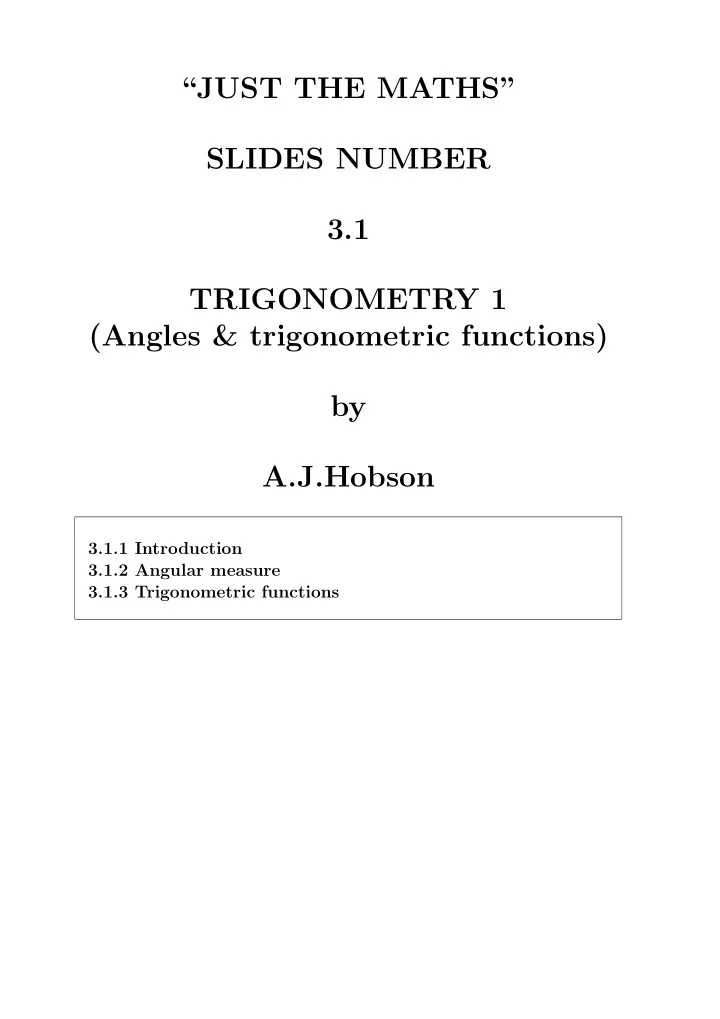

“JUST THE MATHS” SLIDES NUMBER 3.1 TRIGONOMETRY 1 (Angles & trigonometric functions) by A.J.Hobson 3.1.1 Introduction 3.1.2 Angular measure 3.1.3 Trigonometric functions
UNIT 3.1 - TRIGONOMETRY 1 - ANGLES AND TRIGONOMETRIC FUNCTIONS 3.1.1 INTRODUCTION The following results will be assumed without proof: (i) The Circumference, C , and Diameter, D , of a circle are directly proportional to each other through the formula C = πD or, if the radius is r , C = 2 πr. (ii) The area, A , of a circle is related to the radius, r , by means of the formula A = πr 2 . 3.1.2 ANGULAR MEASURE (a) Astronomical Units 1 The “degree” is a 360 th part of one complete revolution. It is based on the study of planetary motion where 360 is approximately the number of days in a year. 1
(b) Radian Measure A “radian” is the angle subtended at the centre of a circle by an arc which is equal in length to the radius. A ✡ r ✡ ✡ ✡ 1 ✡ B C r RESULTS (i) There are 2 π radians in one complete revolution; or π radians is equivalent to 180 ◦ A ✡ ✡ ✡ ✡ θ ✡ B C r (ii) In the above diagram, the arclength from A to B will be given by θ 2 π × 2 πr = rθ, assuming that θ is measured in radians. 2
A ✡ ❅ ✡ ❅ ❅ ❅ ❅ ✡ ❅ ❅ ❅ ❅ ❅ ❅ ✡ ❅ ❅ ❅ ❅ ❅ ❅ ❅ ❅ θ ✡ ❅ ❅ ❅ ❅ ❅ B C r (iii) In the above diagram, the area of the sector ABC is given by 2 π × πr 2 = 1 θ 2 r 2 θ. (c) Standard Angles The scaling factor for converting degrees to radians is π 180 and the scaling factor for converting from radians to de- grees is 180 π . ILLUSTRATIONS 1. 15 ◦ is equivalent to 180 × 15 = π π 12 . 2. 30 ◦ is equivalent to 180 × 30 = π π 6 . 3. 45 ◦ is equivalent to 180 × 45 = π π 4 . 4. 60 ◦ is equivalent to 180 × 60 = π π 3 . 3
5. 75 ◦ is equivalent to 180 × 75 = 5 π π 12 . 6. 90 ◦ is equivalent to 180 × 90 = π π 2 . (d) Positive and Negative Angles Using cartesian axes O x and O y , the “first quadrant” is that for which x and y are both positive, and the other three quadrants are numbered from the first in an anti- clockwise sense. y ✻ ✲ x O From the positive x -direction, we measure angles posi- tively in the anticlockwise sense and negatively in the clockwise sense. Special names are given the to type of angles obtained as follows: Angles in the range between 0 ◦ and 90 ◦ are called 1. “positive acute” angles 2. Angles in the range between 90 ◦ and 180 ◦ are called “positive obtuse” angles. 3. Angles in the range between 180 ◦ and 360 ◦ are called “positive reflex” angles. 4. Angles measured in the clockwise sense have similar names but preceded by the word “negative” . 4
3.1.3 TRIGONOMETRIC FUNCTIONS For future reference, we shall assume, without proof, the result known as “Pythagoras’ Theorem” . This states that the square of the length of the hypotenuse of a right- angled triangle is equal to the sum of the squares of the lengths of the other two sides. ✟ ✟✟✟✟✟✟✟✟✟✟✟ hypotenuse opposite adjacent θ DEFINITIONS (a) “Sine” opposite sin θ ≡ hypotenuse; (b) “Cosine” adjacent cos θ ≡ hypotenuse; (c) “Tangent” tan θ ≡ opposite adjacent . 5
Notes: (i) To remember the above, use S.O.H.C.A.H.T.O.A. (ii) The definitions of sin θ , cos θ and tan θ can be ex- tended to angles of any size: y ( x, y ) ✟ ✟✟✟✟✟✟✟✟✟✟✟ ✻ h ✲ O θ x sin θ ≡ y h ; cos θ ≡ x h ; x ≡ sin θ tan θ ≡ y cos θ. Trigonometric functions can also be called “trigonometric ratios” . 6
(iii) Basic trigonometric functions have positive values in the following quadrants. ✻ S ine A ll ✲ T an C osine (iv) Three other trigonometric functions are sometimes used and are defined as the reciprocals of the three basic functions as follows: “Secant” 1 sec θ ≡ cos θ ; “Cosecant” 1 cosec θ ≡ sin θ ; “Cotangent” 1 cot θ ≡ tan θ. 7
(v) The values of the functions sin θ , cos θ and tan θ for the particular angles 30 ◦ , 45 ◦ and 60 ◦ are easily obtained without calculator from the following diagrams: ✁ ✁ ❆ ❆ ✁ ❆ ✁ ❆ 30 ◦ 30 ◦ ✁ ❆ ✁ ❆ ✁ ❆ ✁ ❆ 2 2 ✁ ❆ ✁ ❆ � � ✁ ❆ √ √ � ✁ ❆ 45 ◦ 3 2 � ✁ ❆ 1 � ✁ ❆ � ✁ ❆ � ✁ ❆ � ✁ ❆ 60 ◦ 60 ◦ 45 ◦ � ✁ ❆ 1 1 1 The diagrams show that (a) sin 45 ◦ = 2 ; (b) cos 45 ◦ = 2 ; (c) tan 45 ◦ = 1; 1 1 √ √ √ (d) sin 30 ◦ = 1 (e) cos 30 ◦ = 2 ; (f) tan 30 ◦ = 3 1 2 ; 3 ; √ √ √ (g) sin 60 ◦ = 2 ; (h) cos 60 ◦ = 1 (i) tan 60 ◦ = 3 2 ; 3. 8
Recommend
More recommend